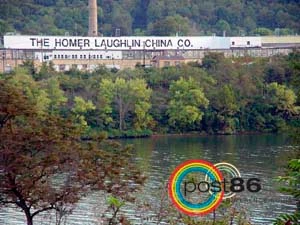History
There are numerous books available from authors who articulate the actual history of Fiesta® much more fully than I have the space to do here. I recommend “Collector’s Encyclopedia of Fiesta® Tenth Edition” by Bob & Sharon Huxford or “Fiesta®, Harlequin, Kitchen Kraft Dinnerwares” by The Homer Laughlin China Collectors Association if you would like a more in-depth history. With that being said, I am just going to do a timeline so you can see at a glance the history of Homer Laughlin China and Fiesta®
1871 – Brothers Homer and Shakespeare Laughlin started a pottery company along the Ohio River in East Liverpool, OH. The company was called “Ohio Valley Pottery” and later changed to “Laughlin Bros. Pottery”.
1873 – The Laughlin brothers won a competition to produce white ware that was worth $5000.00 from the East Liverpool, OH city council. With those winnings the brothers built a two kiln plant. (Plant 1)
1876 – The brothers were awarded a medal at the Centennial Exposition in Philadelphia, PA for the best white ware.
1877 – Shakespeare Laughlin left the company. The company was renamed “Homer Laughlin China Works”.
1889 – William Edwin Wells was hired as a bookkeeper and later managed the business.
1896 – The company was renamed “The Homer Laughlin China Company”.
1897 – Homer Laughlin retired and sold the company to William Edwin Wells, Louis I., Marcus and Charles Aaron. Louis I Aaron became president with William Edwin Wells the secretary and general manager.
1899 – Plant No 2 was built in East Liverpool, OH.
1901 – Plant No 3 was built in East Liverpool, OH.
1902 – A tract of land in Newell, WV was purchased from the Newell family as the company had outgrown its East Liverpool plants.
1904 – Construction started on the metal suspension bridge between East Liverpool, OH and Newell, WV which is owned by The Homer Laughlin China Company. It opened on July 4, 1905.
1905-1906 – Plant No 4 was constructed on the Newell, WV property.
1907 – The company’s headquarters moved from East Liverpool, OH to the Newell, WV plant.
1911 – Louis I. Aaron retired, and his son Marcus Aaron became president of Homer Laughlin.
1914 – Plant No 5 was opened in Newell, WV.
1924 – Plant No 6 was constructed in Newell, WV, with the company’s first continuous tunnel kiln.
1926-1928 – Plant No 4 was equipped with tunnel kilns.
1927 – Plant No 7 was opened in Newell, WV. Frederick Hurten Rhead was hired as design director.
1929 – Construction began on Plant No 8 in Newell, WV. Plants 1, 2, and 3 in East Liverpool, OH closed. A decorating tunnel kiln was added in Plant No. 5.
1930 – William E. Wells retired and Joseph Mahan Wells, Sr. took over as general manager.
1936 – January 9, 1936 HLC introduced Fiesta® dinnerware at the annual Pottery and Glass Exhibit in Pittsburgh, Pennsylvania. Original colors of Red, Yellow, Old Ivory, Green, and Blue.
1937 – Turquoise added to the Fiesta® dinnerware line.
1940 – Marcus Aaron retired, and his son Marcus Lester Aaron became president.
1944 – Red was discontinued.
1951 – Old Ivory, Green, and Blue discontinued. Rose, Chartreuse, Forest and Gray added to the Fiesta® dinnerware line.
1959 – Rose, Chartreuse, Forest and Gray were discontinued. Red was returned to the Fiesta® dinnerware line. Green (a.k.a “Medium Green”) was added to the Fiesta® dinnerware line.
1960 – Joseph Mahan Wells Sr. retired, and his son Joseph M. Wells, Jr. took over as general manager.
1967 – Amberstone was introduced. It was sold by J & H International through major grocery store chains as a promotion.
1969 – Red, Yellow, Green (a.k.a “Medium Green”) and Turquoise discontinued. Fiesta® Ironstone was introduced in the following colors, Mango Red, Antique Gold and Turf Green. Mango Red was not a new color to HLC. It was the Fiesta® vintage Red color renamed for the Fiesta® Ironstone line.
1970 – Casualstone which used Fiesta® Ironstone Antique Gold wares (with a decoration added on some pieces). Casualstone was sold through grocery stores chains as a promotion by Coventry Ware.
1973 – HLC discontinued the Fiesta® dinnerware line due to lack of sales.
1984 – Jonathan Parry became Art Director.
1986 – Joe Wells, Jr. retired, and his son Joe Wells III replaced him. Marcus L Aaron retires and his son Marcus Pete Aaron II replaced him.
Under the guidance of HLC’s art director Jonathan Parry, Fiesta® was reintroduced on February 28, 1986, with the introduction of White, Black, Rose, Apricot and Cobalt Blue and in 24 different pieces. Medium vase, bud vase, pyramid candleholder, round candleholder, salt/pepper shaker, sugar/creamer/tray set, covered individual sugar, creamer, sauceboat, disc pitcher large, disc pitcher small, coffee server, covered teapot large, saucers, cup, bouillon, fruit bowl, bowl – small, bowl – medium, bowl – 1 quart , covered casserole 70 oz., chop plate, dinner plate, luncheon plate, salad plate, bread & butter plate, large oval platter and the small oval platter. 1989 – Marcus Lester Aaron retired, and his son Marcus Pete Aaron II became president.
2002 – Joe Wells III, and his sisters Elizabeth McIlvain and Jean Wicks bought out the Aaron family interest in the company. Joe Wells, III became president and CEO (chief executive officer).
2010 – HLC purchased The Hall China Company located in East Liverpool, OH
2012 – Joe Wells, III retired and his sister Elizabeth McIlvain became president.
2020 – HLC sold “The foodservice divisions and brand names of The Homer Laughlin China Company (HLC) and the Hall China Company are acquired by Steelite International. The Homer Laughlin China Company is renamed as The Fiesta Tableware Company.” (fiestafactorydirect.com/pages/timeline-history)

